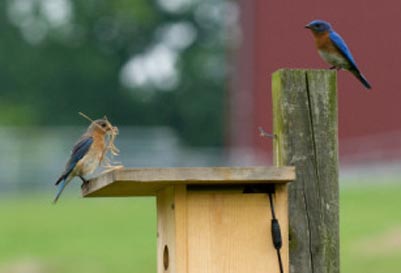Upland Cavity Nesters
|
American Kestrel, Barred Owl, Red-headed Woodpecker, Red-bellied Woodpecker, Yellow-bellied Sapsucker, Downy Woodpecker, Hairy Woodpecker, Northern Flicker, Pileated Woodpecker, Black-backed Woodpecker, Great Crested Flycatcher, Black-capped Chickadee, Boreal Chickadee, Tufted Titmouse, Red-breasted Nuthatch, White-breasted Nuthatch, Eastern Screech-owl, Barn Owl, Eastern Bluebird, Tree Swallow
|
The majority of cavity-nesting bird species have increased between the first and second atlases. Gains (238 blocks or 275 percent on average) were much greater than losses (92 blocks or -34 percent on average) in block occupancy for all species in this group combined.
- Group includes 8 species of “primary cavity nesters” (woodpeckers); 4 species of “weak cavity nesters” (chickadees and nuthatches; excavate cavities in wood that has been suitably softened by decomposition, or use existing cavities); and 9 species of “secondary cavity nesters” (only use existing cavities).
- Most cavity-nesters occupied more blocks in the second Atlas than in the first, with species making dramatic gains (275 percent on average) compared to species exhibiting losses (-34 percent on average).
- Increases in Tufted Titmouse and Red-bellied Woodpecker are a result of a northward range expansion.
- Maturation of forest likely contributed to gains for Barred Owl, Pileated Woodpecker, Red-breasted Nuthatch, Black-backed Woodpecker, and Yellow-bellied Sapsucker.
- Provision of nest boxes may have benefitted Eastern Bluebirds.
- Declines for two secondary cavity nesters (Eastern Screech-owl and American Kestrel) may be correlated to declines in two primary cavity nesters (Yellow-shafted Flicker and Red-headed Woodpecker), who excavate cavities of appropriate size for both birds of prey. In addition, all four species are associated with farmlands, a declining habitat.







